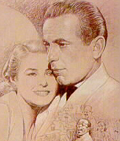Study Guide -
Amistad (1997)
|
Director : Steven Spielburg
Stars :
Morgan Freeman .... Joadson
Nigel Hawthorne .... Martin Van Buren
Anthony Hopkins .... John Quincy Adams
Djimon Hounsou .... Cinque
Matthew McConaughey .... Baldwin
|

|
Preparation :
Read the movie reviews by Roger Ebert and the NY Times Review. Also read The Faulty History article and "The Amistad Case in Fact and Film."
Historical/Social Significance :
Although the movie has been criticized for some faulty history including that the African American abolitionist, Theodore Joadson (played by Morgan Freeman), is a composite character. However the movie does show how the slave trade was illegal (since 1808), while slavery was still legal in the Southern states. It also has tremendous scenes of the slave crossing and some good scenes involving the slave trade in Africa where enemy tribes sell their enemies to slave traders. Amistad is also important in showing the views of the abolitionists which is important as a prelude to the Civil War.
"The historical strength of Amistad is in its portrayal of the Africans, and most strikingly in its representation of the seizure of Cinque, the Middle Passage, and the revolt. Natalie Zemon Davis Slaves on Screen
Synopsis :
The film is based on a true story, which took place in 1839. Fifty three Africans captives are led by Cinque seize control of their ship. After two months at sea the ship is captured by an American naval ship off the coast of Connecticut. The Africans are then placed on trial.
Guided Questions for Viewing :
Assessment questions will be based on the following :
-
"Amistad's black character's are essentially foils for white self-discovery and moral growth."1 Comment on this statement.
-
The movie is mainly about a legal issue, not what is "right". Discuss the legal issue.
-
Describe what was the most powerful scene in the movie to you.
-
The meeting between Cinque and former President John Quincy Adams is fictional, but powerful. Do you think it should have been included?
- Describe the changing views of lawyer Baldwin as the movie goes on.
- Describe the actions and motivations of President Martin Van Buren in the movie.
- As in most historical films. Spielburg made concessions to make the story more entertaining. Why you think he should have done this and should he have?
-
Although there were some liberties taken with the facts, there is much history to be discovered in watching The Amistad. What did you learn watching the movie?
-
"This problem is compounded by having the Africans speak Mende, a West African language, with English subtitles. A courageous decision by Hollywood standards, this device backfired along the way when someone realized that Americans do not like subtitled movies, as foreign filmmakers have known for decades. In the end, most of the Mende dialogue ended up on the cutting- room floor. Apart from the intrepid Cinque, the Africans' leader, we never learn how the captives responded to their ordeal. It would have been far better to have the Africans speak English (the film, after all, is historical fiction), rather than rendering them virtually mute. " American Historian Eric Foner.
Do you agree with the above statement? Would having the captives speak English have made the movie better?
Sources:
1.
Foner, Eric. "The Amistad Case in Fact and Film", http://historymatters.gmu.edu/d/74
Hill, Jim.. "Schools use Amistad as Film Guide", http://www.cnn.com/SHOWBIZ/9712/10/amistad.study.guides.flap/
Maslin, Janet. NY Times Review, http://movies2.nytimes.com/gst/movies/movie.html?v_id=158798
Ebert, Roger. "Amistad." Dec. 12, 199. http://www.rogerebert.com
Roquemore, John. History Goes to the Movies 1999. p. 45
Davis, Natalie. Slaves on Screen (2002)
|



